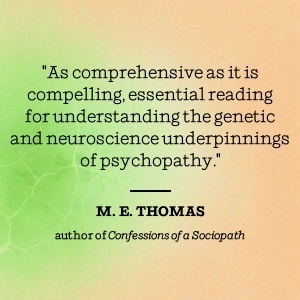Customer Services
Copyright © 2025 Desertcart Holdings Limited
Desert Online General Trading LLC
Dubai, United Arab Emirates


Full description not available



A**A
The Perfect Book for an Aspiring Neuroscientist!
For decades now, neuroscientists have been seeking the answer the question, “What makes a psychopath, a psychopath?” In James Fallon’s, The Psychopath Inside, he wanted to uncover the answer to that question by studying the brains and genes of psychopaths. Unknown to him at the time, this research would lead him to make a detour towards having to re-evaluate his own personal life. Fallon is an accredited science writer who discusses his various projects that he has been working on in psychopathology, one of them being himself. With a background in neurobiology, he is a renowned professor in the department of Psychiatry and Human Behavior at the School of Medicine at the University of California, Irvine.Fallon is not shy about his work or family history and has been published in various articles such as The Wall Street Journal, been asked to speak at a national conference (TED), and was even contacted by the producer of the Criminal Minds television show due to his psychopathological findings. However, his most successful work is his book, The Psychopath Inside, acting not only as a factual and knowledge-based book, but an autobiography as well.The lurking question, “What is a psychopath?” lingers in conversation between researchers because it has yet to have an agreed upon definition. Fallon begins by acknowledging common facts agreed on by the majority of researchers: psychopaths lack empathy and disregard morals, right? Correct. Using these facts and his countless amount of research, Fallon discovers that there are not only areas in the brain that are similar between psychopaths, but also genetic sequences.James Fallon did a blind review of over a hundred PET scans which came from both average people and from those who were diagnosed as psychopaths. Looking closely at the various scans, he recognized a pattern in the scans of those deemed as psychopaths: a major loss of activity in the limbic (emotional) cortex of the brain. However, this pattern didn’t interest Fallon enough to pursue it further and he decided to continue with his other Alzheimer’s trial. During the Alzheimer’s trial, Fallon established a control group of brain scans who did not has Alzheimer’s, and these scans happened to be those of his family. Looking closely at his family scans, he noticed a similarity in a PET scan that looked familiar to him; it looked like a psychopath scan which he had studied previously. Turns out, the scan which he had been looking at was a scan of his own brain.After that finding, Fallon’s interest in psychopathology peaked. Looking at someone’s genetic pattern is like looking at a blue-print of a house someone is building. Genetics is the foundation of life, through which DNA plays a leading role. Basing his research under that model, Fallon began to look at psychopaths’ genetic patterns and compared and contrasted them.Fallon began to look closely at his origin: his family life, the environment he grew up in, and activities that he pursued throughout his lifetime. He asked a number of questions to his family and friends, through which Fallon concluded that he was a happy, spirited, and confident child throughout his youth. As many other neuroscientists have agreed upon, bed-wetting, playing with fire, and animal abuse are main causes of concern when a child is developing because this suggests they are likely to be psychopathic. Fallon disregards that statement because he believes that “boys will be boys” and they just happen to do these sorts of things or it could just be peer pressure. So with this being said, the problem still remained, why did his brain scan resemble one of a psychopath?Fallon develops a three-legged stool theory as a way to account for how a person becomes a psychopath. He establishes this theory based off of three parts: genes, a specific brain pattern, and childhood abuse. However, this theory does not fit all because Fallon’s PET scans resemble those of a psychopath yet he didn’t have any childhood abuse while growing up. Therefore, Fallon calls himself a “lucky psychopath”, because he was brought up in a loving family and was not raised to have these tendencies many psychopaths do.This is where my favorite part of the book comes into play because Fallon discusses how having psychopaths in society isn’t so bad. Who would have thought, right? For example, psychopaths are defined to have less stress because they aren’t empathetic to others and don’t care how others go about their lives. With this lack of stress, they have healthier immune systems are and less susceptible to diseases and can live longer and healthier lives for the most part. Also, with this lack of emotion, people with psychopathic tendencies can better lie and be able to get away with it, saving themselves potential trouble.Fallon’s book is unlike any other scientific novel because he not only incorporates facts and real-life PET scans, but also discusses his private life and family history. One should not be nervous to try to read this book because of its organization and ability to be followed easily. Fallon proves to do an excellent job describing his work and its significance and ties it back to how it relates to psychopathology. This leaves little to no room for a reader to get lost among his words. Through his writing, he provides many analogies for complex topics such as serotonin processes and activating systems which make it easy to understand, so lack of a neuroscience degree won't leave you lost and confused.After reading this book and even re-reading certain passages, I, without hesitation, would give it a 5/5 rating. I was drawn to the book immediately by the way in which James Fallon began introducing himself and establishing his authority on the topic of psychopathology. His unique style of writing, one that is easy to comprehend, attracted me to his book because I could follow along with the various new details he was using to support his findings. This book proved to be an insightful look into Fallon’s personal life and demonstrated to the reader how fascinating our brain truly is. It was eye-opening to learn how observations, thoughts, and emotions that plagued people throughout their childhood could make them more or less susceptible to psychopathy. Fallon pushed past the various controversies which the field of psychopathology held and stood his ground and continued his research, and he will soon hopefully unlock the mystery behind "psychopaths".
L**N
Too Much Information
James Fallon, a noted neuroscientist, discovers he has the brain of a psychopath (a group he has been studying and when he and his family become control subjects for the psychopathic experimental group lo and behold he becomes an unusual control as he learns he has the brain of a psychopath). Specifically, he learns his family (on one side) is filled with killers, impulsively dangerous people and murderers. He has a genetically wild side and we learn about it, women, gambling, over eating staying up all night partying). He announces he is a lapsed catholic and a libertarian but his day job is as a serious neuroscientist. He also has a compassionate and wonderful wife (I hope she still is after reading the book). The book is a reality show with James Fallon the man upstaging James Fallon the respected neuroscientist. The meat on the bones of this book is that Fallon's discoveries of his psychopathic brain reminds us that the social neurosciences and the developing field of Neurolaw have to move forward carefully in the murky waters of translational brain imaging research and not simplistically show up in court saying "My Amygdala made me do it" (the new Twinkie defense) when that might be more than a stretch. Fallon wonders why he is not a killer like so many of his relatives and what he discovers is the gist of the book. It is a hard book to put down as Fallon takes on a personal tour, almost a manic journey into his personal life; with many questions unanswered (I hope the killer never emerges in him as a self fulfilling wish). When he turns to science (almost a disconnect from the purpose of the book) he demonstrates himself as a serious neuroscientist. The book is a tell all biography into Fallon's mischievous life outside the lab but it is also a journey into the problems in translational research. Just because something looks like a duck and sounds like a duck doesn't mean it is a duck. And this is where Fallon's book serves as a warning to those who would have taken Fallon's brain images to court and argued that he should be civilly committed as a potential psychopath. Researches in the field might take heed of his warning that translating fMRI images into the courtroom should be done with caution. It is a fast read and an expose (not entirely scientific). I recommend it as a reminder that what goes as good science by some psychopathy researchers needs to be reconsidered as possibilities, not truths. In the future we need to have real clinicians working with psychopaths working alongside the neuroscience researchers in order to keep both sides honest. His book will actually be a setback for some lawyer's using fMRI images to support a lack of free will defense but also expand the possibilities of how to understand how our complex brains cannot be reduced to a series of fMRI images
J**S
Tremendous amount of information. I had no idea that reserchers could know so much from brain waves.
I read the author's article in the Atlantic that led to this book. The article was several years ago, but it was very clear and powerful and stuck with me. At the time I did not know that the author was a noted neuroscientist and had much more to tell than his life experience, interesting as it is.There is a lot of technical information in the book, and I sometimes missed understanding some of the detail (I could have used a few more illustrations of the parts of the brain, closer to the text where the knowledge was needed) but I am o.k. skipping over that if the big idea is described, as it was in this book.One of the major strengths of this book is the author's understanding: Of how he is different from others, and how his family and friends are still friends despite finding deficits in him. Of how he sees that he is "missing something" by almost never having the emotions that most of us have. Of why he has the brain of a psychopath but not (much of) the socially harmful part of it. (You'll have to read the book for that -- It's complicated.)He describes why being a psychopath develops along with the part of the brain that gives most maturing adolescents reason, so it is seldom seen in small children. The saddest part to me was when his mother told him she knows the sweet little boy she knew is still inside him, and he said (to himself) that sweet little boy is gone.
Trustpilot
3 weeks ago
4 days ago